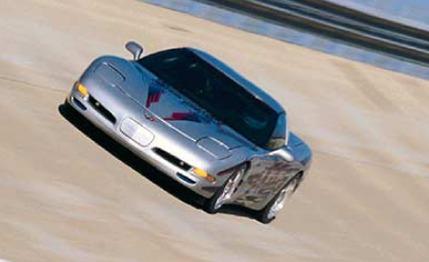 Specialty File
Specialty File
After two years of development, master tuner John Lingenfelter hit a horsepower wall with the naturally aspirated LS1 aluminum V-8. The compromises necessary to keep the V-8 emissions legal and running properly under the watchful eye of OBD II government regs limited the possible modifications. That didn't stop Lingenfelter from trying, however, and his 383-cubic-inch, 450-horsepower LS1 is no slouch. Installed in a C5 Corvette, the 383 pushes the car to 60 mph in 3.9 seconds and through the quarter-mile in 12.1 seconds at 120 mph.
For Lingenfelter and his customers - some of whom own 650-hp modified ZR-1s - that simply wasn't enough, so Lingenfelter turned to turbocharging.
His company, Lingenfelter Performance Engineering of Decatur, Indiana, plans to offer two turbo packages for C5 Corvettes. Stage I consists of two turbos mounted on a stock engine generating a mild 5 psi of boost. Stage II will use the same turbos but with more boost, beefed-up engine internals to handle the extra stress, and some body modifications to stabilize the Corvette's wandering tendencies above 200 mph. Last December, we tested the car pictured here, a Stage I C5 Corvette. Stage II should be available about the time you read this.
Slapping two turbos into a Corvette is not simple. First, you need to choose the turbo (or turbos), and then you need to find room for the turbos and their associated hardware in the Corvette's crammed engine bay.
Lingenfelter uses Garrett T28 turbos that were originally designed for the Japanese-market Nissan Skyline GT-R. The T28s use fully lubricated ball bearings for low friction and water-cooled jackets for long-term reliability. The original turbo housings did not properly position the turbo intake and exhaust passages when installed in the Corvette, so Lingenfelter went to turbocharging specialist Incon Systems of Berea, Ohio, to build turbo housings for the Corvette. Basically, the turbos use Garrett rotating assemblies with Incon Systems housings.
Each turbo lies between a new cast-iron Lingenfelter exhaust manifold and the stock catalytic converter. There are separate air-to-air intercoolers for each turbo, mounted forward of the front wheels. At the low boost pressure this system generates, Lingenfelter says the intercoolers are able to keep the intake-air temperature within 20 degrees of ambient air.
The turbos are mounted lower than the engine sump, so Lingenfelter installs a drain tank and scavenge pump to return the turbo oil to the main lubrication system.
Except for some computer reprogramming that fine-tunes the spark timing and fuel calibration and raises the rev limiter 200 rpm to 6400, the rest of the engine is stock. Lingenfelter says the low boost level doesn't cause detonation at the stocker's 10.1:1 compression ratio and the engine internals are up to the job of higher horsepower. When the installation is finished, the twin-turbo motor belts out 500 horsepower at 5800 rpm and 500 pound-feet of torque at 4600 rpm. We're talking significant gains here - up 45 and 43 percent from the stock Vette's 345 hp and 350 lb-ft of torque, respectively. The Stage I turbo motor even outdoes Lingenfelter's own 383 LS1 package by 50 hp and 60 lb-ft.